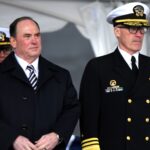
The Navy’s flat fiscal year 2022 budget request prioritizes readiness and future investment over current capabilities, according to a Navy official. When accounting for inflation, the Navy’s fiscal year 2022 budget request, at $212 billion, stands flat compared to the current year, mirroring how the total FY ‘22 Defense Department budget request is also flat versus the current year at about $715 billion. Last Friday, a Navy official explained some decisions were made both to funnel more funds into readiness…

 By
By 











